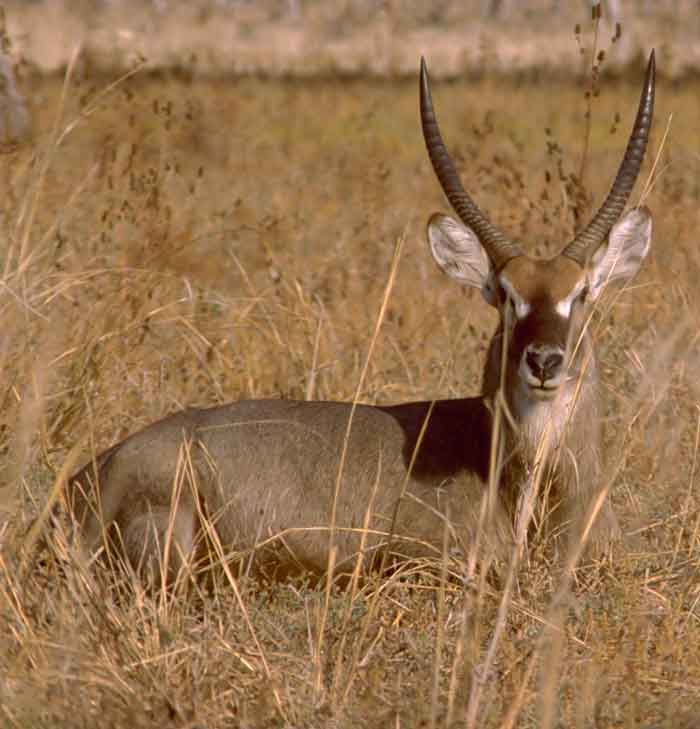Kobus ellipsiprymnus (*) Cladus: Eukaryota Name Kobus ellipsiprymnus Ogilby, 1833 Type locality: South Africa, between Lataku (near Kuruman) and W coast of Africa, N of Orange River, on Molopo River Vernacular names
* Kobus ellipsiprymnus on Mammal Species of the World. The Waterbuck (Kobus ellipsiprymnus) is a large antelope found widely in Sub-Saharan Africa. Waterbuck stand 120 to 136 centimetres (47 to 54 in) at the shoulder.[2] Males weigh 200–300 kilograms (440–660 lb) and females 160–200 kilograms (350–440 lb).[2] Their coats are reddish brown in colour and become progressively darker with age; they have a white 'bib' under their throats and white on their rumps. The waterproofing secretions of the waterbuck's sweat glands produces an unpleasant odor in its meat, unless the animal is skinned carefully. According to African myth the meat of the waterbuck is not edible, but this is untrue—whilst not especially tasty, waterbuck venison is safe to eat. The long spiral structured horns, found only in males, sweep back and up. Waterbuck are found in scrub and savanna areas near water where they eat grass. Despite its name, the waterbuck does not spend much time in the water, but will take refuge there to escape predators. Waterbuck are diurnal. Females gather in herds of between two and six hundred individuals. Males keep territories of around three hundred acres (1.2 km²) during their prime. They usually lose their territories before the age of ten. The Waterbuck occurs in two main groups, which formerly have been treated as separate species, but they interbreed where their ranges come into contact.[3] The first group is the Defassa Waterbuck with a white rump patch. It is found west of the Great Rift Valley, ranging from Ethiopia west to Senegal and south to Zambia. The second is the Ellipsen Waterbuck, which has a white ring on the rump that extends above the tail. It is found in south-east Africa, ranging from southern Somalia to South Africa and inland to the Great Rift Valley. Some authorities accept only these two as valid subspecies, with the trinomial K. e. defassa for the Defassa Waterbuck and K. e. ellipsiprymnus for the Ellipsen Waterbuck.[1][2] Others treat the Defassa and Ellipsen Waterbucks as subspecies groups, with as many as 13 separate subspecies in total,[3] among others based on differences in overall colour.[4] In that case, the Ellipsen Waterbuck includes the first four subspecies in the following list (ellipsiprymnus to thikae), while the Defassa Waterbuck includes the remaining:[3] K. e. ellipsiprymnus (Ellipsen Waterbuck) group: References ^ a b IUCN redlist. Cited works IUCN SSC Antelope Specialist Group (2008). "Kobus ellipsiprymnus". IUCN Red List of Threatened Species. Version 2010.4. International Union for Conservation of Nature. Retrieved 2011-06-15. Database entry includes justification for why this species is listed as Least concern Further reading "AWF: Wildlife: Waterbuck". awf.org. African Wildlife Foundation. Source: Wikipedia, Wikispecies: All text is available under the terms of the GNU Free Documentation License |
|


